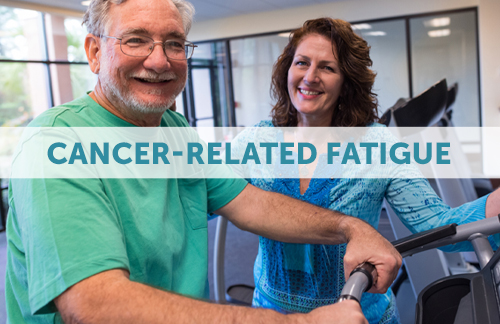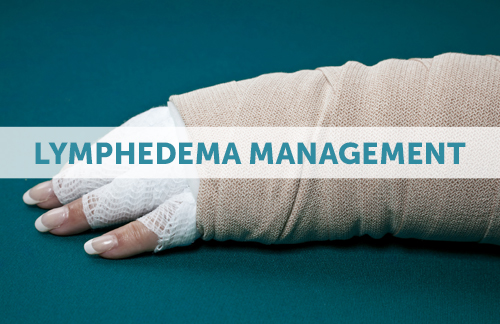Cancer Care Physical Therapy
Physical therapy is an important part of a cancer recovery healthcare plan. Physical therapists are adept at working with patients to address unique challenges that may arise from the treatment of cancer. By going to a physical therapy program patients are given a treatment plan based specifically on their needs, and ability levels. Improving the quality of life is one of our main goals.
Common Cancer Care Services
- Balance and fall prevention
- Cancer-related fatigue
- Edema
- Muscle strengthening
- Post-surgical recovery
Our physical therapy teams are motivational. Instead of focusing on what you can’t do, we focus on what you can – gently pushing you forward both emotionally and physically to get you to where you need to be. If you’re ready to take the next step, we’re here for you.
Common Cancer Care Physical Therapy Services

Cancer-Related Fatigue
Expand For More Info
Cancer-Related Fatigue (CRF) is a feeling of extreme tiredness and is usually accompanied by other symptoms. CRF is a debilitating condition that can seriously affect your health and quality of life. Most importantly it can significantly interfere with your home life and may limit the effectiveness of chemotherapy cycles. It is the number one complaint of cancer patients and it is a nearly universal problem affecting 78% to 96% of those undergoing treatment.
Signs and Symptoms
- Chronic pain
- Leg pain
- Difficulty with balance
- Shortness of breath after light activity
- Difficulty walking short distances
- Difficulty performing daily tasks
- Extreme weariness and tiredness
- Difficulty sleeping
Why Cancer-Related Fatigue Happens
- Reduced energy to repair damaged tissue
- The buildup of toxic substances
- Effect of biologic therapy on the immune system
- Changes in sleep/wake cycle
Previous advice for cancer patients was often to get more rest and avoid activities that are physically challenging. However, recent studies have shown that exercise was found to be effective in preventing or reducing Cancer Related Fatigue. No adverse effects from exercising have been reported. “Identified as remarkably underutilized, exercise is one of the few interventions suggested to diminish CRF and other psychosocial symptoms. The positive effect of exercise on CRF should underscore the need for physical therapists’ involvement in the rehab of patients with cancer.”
Program Objectives
- Address pain
- Use non-drug based treatments such as physical modalities
- Alleviate musculoskeletal dysfunction
- Improve posture
- Combat effects of bed rest
- Help to maintain muscle strength and flexibility, and restore muscle balance
- Help to decrease depression by increasing endorphins
- Improve balance
- Improve endurance
- Core body strengthening
Physical and occupational therapy can help a patient regain/keep their strength and mobility as they are treated and recover from cancer. Licensed therapists have the tools to bring a patient to their full function safely through exercise and education.

Lymphedema Management
Expand For More Info
Lymph is the fluid that bathes the cells with needed nutrients, oxygen, and white blood cells provided by the circulatory system. Lymph is very important to the health of cells and tissues and helps the body fight infection. Lymph vessels remove waste products from the cells encouraging healthy circulation.
One of the complications from radiation treatment, or more often when lymph nodes are surgically removed is swelling due to a compromised lymph system. The incidence of pain-generating edema has been estimated to be as high as 70% in these breast cancer patients. Physical therapy can reduce edema by performing techniques such as Complete Decongestive Therapy (CDT).
Lymphedema Treatment Includes
The treatment of peripheral edema requires a combination of techniques to be successful. Complete decongestive therapy consists of the following essential treatment components:
- Evaluation – To determine the proper course of treatment
- Manual lymph drainage – A specialized manual technique to move edema from a congested area into an uncongested area where the lymph fluid can be readily absorbed
- Exercise – simple exercises performed daily can improve flexibility, increase strength, and promote lymph flow. These contractions in the edematous area quicken the reduction of the limb, enhancing range of motion, and decreasing pain.
- Compression bandages – increase the tissue pressure which promotes lymph flow and thus reduces lymphedema and orthopedic edemas.
- Compression garments – are primarily used in the treatment of Lymphedema but can be used to control chronic orthopedic and vascular edemas. They are worn once the swelling has been reduced to maintain limb size.
- Home program – Individualized for each patient to include the above treatment techniques.

Post Mastectomy Rehabilitation
Expand For More Info
A physical therapy post-mastectomy program can aid in the overall recovery process by focusing on regaining strength and increasing the range of motion in your shoulder and arm. Early intervention by a physical therapist can help women regain full function following mastectomy surgery, regardless of whether or not a woman has had reconstruction.
Rehabilitation is always tailored to each patient’s specific needs. Not every patient experiences the same recovery, and as such physical therapists are prepared to help patients experiencing a multitude of symptoms – some have been highlighted below.
Post-Mastectomy Rehab Programs
Size, location, and the type of mastectomy are important considerations when choosing a type of treatment. Exercises to maintain shoulder range of motion and arm mobility may be prescribed as early as 24 hours after surgery. These exercises are important in restoring strength and promoting good circulation. As rehabilitation progresses these exercises may be modified to meet new goals.
Numbness and/or nerve sensitivity at the surgical site can develop post-mastectomy. Manual therapy can help restore sensation and relieve nerve pain. In severe cases, a chronic condition known as post-mastectomy pain syndrome may develop. This is caused by scar tissue impinging on nerves. Physical therapy can be very effective at releasing scar tissue and reducing this nerve-related pain.
Scar tissue formation may cause tightness around the surgical site leading to very dense tissue under the incision, which is painful and can restrict range of motion. The restricted range of motion puts a woman at risk for a painful condition known as frozen shoulder. Early treatment by a physical therapist can help reduce the pain and help regain functional range of motion and strength.
Benefits of Physical Therapy
- Improved shoulder range of motion
- Improved shoulder strength
- Improved functional mobility
- Improved posture
- Decreased pain at the surgical site
- Decreased edema on the affected side
- Improved sensation at the surgical site

